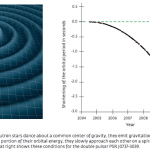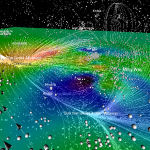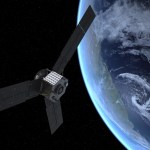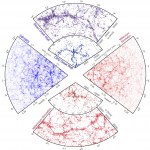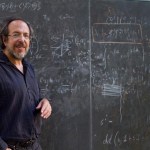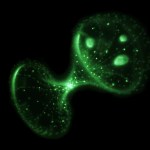gravity
"There was a long history of speculation that in quantum gravity, unlike Einstein's classical theory, it might be possible for the topology of spacetime to change." -Edward Witten
General relativity makes very specific prediction for what the curvature of space should be at the event horizon of a black hole, and for the consequences to spacetime are for a mass accelerating outside, near and through it. However, a fully quantum theory of gravity is needed to understand what happens at or near a black hole's singularity.
Image Credit: Caltech/MIT/LIGO Lab, of the first gravitational wave…
First, what is a gravitational wave?
I find it interesting that some people are expressing difficulty in understanding what a gravitational wave is, as though everybody (who is not a physicist) has a perfectly good understanding of what any kind of wave is. We don't need to go too deeply beneath the surface, as it were, to understand this well enough to be amazed at the discovery, but not well enough to get a job being a Gravitational Waveologist.
Imagine a perfectly flat pond. Imagine throwing a stone out into the middle of the pond. Now imagine ripples, tiny waves, spreading out from the…
"Ladies and gentlemen, we have detected gravitational waves." -David Reitze
More than 100 years after Einstein's relativity came out, one of its last great predictions -- the existence of gravitational radiation -- has been directly experimentally confirmed! The LIGO collaboration has observed two ~30 solar mass black holes merging together, producing a slightly less massive final black hole as three sun's worth of mass was converted into energy via Einstein's E = mc^2.
Image credit: R. Hurt – Caltech/JPL.
This type of event, although quite serendipitous for the LIGO collaboration, is…
"Einstein's gravitational theory, which is said to be the greatest single achievement of theoretical physics, resulted in beautiful relations connecting gravitational phenomena with the geometry of space; this was an exciting idea." -Richard Feynman
When we look out into the Universe, we normally gain information about it by gathering light of various wavelengths. However, there are other possibilities for astronomy, including by looking for the neutrinos emitted by astrophysical sources -- first detected in the supernova explosion of 1987 -- and in the gravitational waves emitted by…
"Einstein's gravitational theory, which is said to be the greatest single achievement of theoretical physics, resulted in beautiful relations connecting gravitational phenomena with the geometry of space; this was an exciting idea." -Richard P. Feynman
When Einstein's theory was first proposed as an alternative to Newtonian gravity, there were a number of subtle but important theoretical differences noted between the two. Einstein's theory predicted gravitational redshift, time delays, bending of light and more. But what was perhaps most remarkable is that unlike Newton's gravity, Einstein's…
“The paradigm of physics — with its interplay of data, theory and prediction — is the most powerful in science.” -Geoffrey West
Cosmic inflation, our earliest theory of the Universe and the phenomenon that sets up the Big Bang, didn't just explain a number of puzzles, but made a slew of new predictions for the Universe. In the subsequent 35 years, five of the six have been confirmed, with only primordial gravitational waves left to go.
Image credit: NASA / WMAP science team.
Inflation predicts that they could be large or small, but based on the simplest classes of models and the measured…
"Gravitational and electromagnetic interactions are long-range interactions, meaning they act on objects no matter how far they are separated from each other." -Francois Englert
One of the most spectacular predictions of Einstein's General Relativity was the existence of gravitational lensing, whereby a large foreground mass could act as a lens, magnifying and distorting the background light source behind it. Although this was first observed for quasars, large galaxy clusters act as the most powerful lenses.
Image credit: K. Sharon et al., 2014, via http://arxiv.org/abs/1407.2266.
Which is…
"Learn from yesterday, live for today, hope for tomorrow. The important thing is not to stop questioning." -Albert Einstein
While it's easy to look on Einstein's general theory of relativity — which turns 100 today — as a revolutionary new way to interpret space and time, as well as their interplay with matter and energy, it actually came about due to a problem with the Solar System.
Image credit: NASA / JPL-Caltech / R. Hurt.
The orbits of all the planets, comets and asteroids were explained very nicely by Newtonian gravity, with the exception of Mercury, which precessed a little too…
The Arizona Physiological Society held their 8th annual conference Nov 13-14 at Midwestern University in Glendale. This was a great meeting for comparative physiologists!
Here are some comparative physiology highlights from the meeting:
The 2015 Keynote Speaker was Dr. Andrew Biewener (Harvard University) who spoke about "How do running animals acheive stability? The neuromechanical control of rapid locomotion." In his talk he focused on understanding how Guinea fowl avoid tripping when running really fast over uneven surfaces.
The 2015 Arizona Distinguished Lecture was given by Dr.…
"This scenario implies that the giant planet instability is not the source of the Late Heavy Bombardment and that terrestrial planet formation finished with the giant planets in their modern configuration." -Nathan A. Caib & John E. Chambers
It's a common but nonetheless spectacular occurrence when our leading scientific theories -- the ones with the best explanations for the observed phenomena -- run into conflict with what we see. Sometimes, it's the power of simulations that show us the way.
In 2005, scientists put forth the "Nice Model" to explain the configuration of the Solar…
"Gravitational and electromagnetic interactions are long-range interactions, meaning they act on objects no matter how far they are separated from each other." -Francois Englert
Want a recipe for seeing as far into the distant Universe as you can? Because of how distance and brightness are inversely related, you need to make the most of every photon, build as large a telescope as possible and observe for long periods of time in order to collect the most light.
Image credit: XMM-Newton, ESA, NASA.
But there's an extra bit of magnification that Einstein's General Relativity gives to us for…
We live in a Universe full of galaxies, supermassive black holes, and violence. The violence is particularly relevant here, because every so often, these galaxies merge, and if they each contain a supermassive black hole, the gravitational wave "ripples" that get sent through space will literally shake and affect everything that's in them.
Image credit: NASA, ESA, the Hubble Heritage Team (STScI/AURA)-ESA/Hubble Collaboration and A. Evans (University of Virginia, Charlottesville/NRAO/Stony Brook University), K. Noll (STScI), and J. Westphal (Caltech).
If you had a perfect clock --…
“To me there has never been a higher source of earthly honor or distinction than that connected with advances in science.” -Isaac Newton
If Newton truly meant that sentiment, perhaps he would have been happy to find out that his theory of gravitation -- which stood unchallenged for over 200 years -- was superseded a century ago by Einstein's general relativity. Not only did Einstein's theory reproduce all the successful predictions of Newtonian gravity, but where the predictions differed, Einstein's agreed with observations where Newton's did not.
Image credit: Wikimedia Commons user…
“There is a fifth dimension, beyond that which is known to man. It is a dimension as vast as space and as timeless as infinity. It is the middle ground between light and shadow, between science and superstition.” -Rod Serling
Of course, despite our best theoretical hopes, we know only of four dimensions -- three space and one time -- that exist in our Universe. But what if there not only were a fourth spatial dimension, but it presented itself to us by growing from a microscopic, undetectable state, and then shrank back into one on an annual basis?
Image credit: Paul Falstad’s 3-D…
“The slow philosophy is not about doing everything in tortoise mode. It’s less about the speed and more about investing the right amount of time and attention in the problem so you solve it.” -Carl Honore
If you wanted to know how fast you were moving through space, you'd need to measure it all: the Earth's rotation, our motion around the Sun, the Sun's motion through the galaxy, the Milky Way's speed within the local group, and finally how the local group moved relative to the Universe. All in all, it's a daunting, virtually impossible task without literally measuring everything in the…
Every time you follow the motion of a spacecraft, moon, planet or other object through the Solar System, you're putting the theory of gravity to the test. On one hand, there's a robust set of predictions for what the behavioral motion of these bodies ought to be, while on the other there's what we actually observe. Sometimes, a mismatch indicates the need for something new, like a new planet or a new law of gravity.
Image credit: Sky & Telescope.
But other times, there are mundane explanations that account for these "apparent" discrepancies, such as radioactive decay, heating from…
“First, you should check out my house. It’s, like, kinda lame, but way less lame than, like, your house.” -Lumpy Space Princess, Adventure Time
When you visualize our Universe today, you probably think about the great clumps of matter -- planets, stars, galaxies and clusters -- separated by huge distances. But on the largest of all scales, tens of billions of light years in diameter, any given region of the Universe is virtually indistinguishable from any other.
Image credit: ESA/Herschel/SPIRE/HerMEs, of the Lockman Hole.
But this structured Universe only came about because our Universe…
There's something puzzling about black holes, if you stop to consider it. On the one hand, they're objects so massive and dense -- compacted into such a small region of space -- that nothing can escape from it, not even light. That's the definition of a black hole, and why "black" is in the name.
Image credit: James Provost, sciencenews.org.
But gravity also moves at the speed of light, and yet the gravitational influence of a black hole has absolutely no problem extending not only beyond the event horizon, but infinite distances out into the abyss of space.
Image credit: Henze, NASA.…
If we want to understand the Universe at a fundamental level -- all the forces on all scales -- the biggest obstacle facing us is to come up with a correct, consistent, testable and verifiable theory of quantum gravity. To no one's great surprise, we're not quite there yet.
Image credit: Lee Smolin's book at Amazon.
In 2001, Lee Smolin -- one of the leading thinkers in quantum gravity -- made the bold prediction that,
“We shall have the basic framework of the quantum theory of gravity by 2010, 2015 at the outside.”
While we're not at all there yet, it's still fascinating in its own…
“I just think too many nice things have happened in string theory for it to be all wrong. Humans do not understand it very well, but I just don’t believe there is a big cosmic conspiracy that created this incredible thing that has nothing to do with the real world.” -Edward Witten
It's a difficult fact to accept: our two most fundamental theories that describe reality, General Relativity for gravitation and the Standard Model / Quantum Field Theory for the other three forces, are fundamentally incompatible with one another. When an electron moves through a double slit, for example, its…




